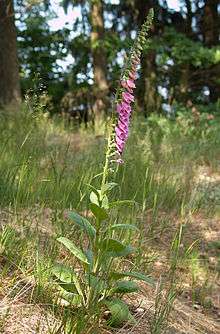Digitalis purpurea
Digitalis purpurea, the foxglove or common foxglove, is a species of flowering plant in the plantain family Plantaginaceae,[1] native to and widespread throughout most of temperate Europe. It is also naturalised in parts of North America and some other temperate regions. The plant is a popular garden subject, with many cultivars available. It is the original source of the heart medicine digoxin (also called digitalis or digitalin).This biennial plant vegetates in the first year after sowing, before flowering and then dying in the second year. It often self-seeds to produce new plants.
| Digitalis purpurea | |
|---|---|
 | |
| Scientific classification | |
| Kingdom: | Plantae |
| Clade: | Tracheophytes |
| Clade: | Angiosperms |
| Clade: | Eudicots |
| Clade: | Asterids |
| Order: | Lamiales |
| Family: | Plantaginaceae |
| Genus: | Digitalis |
| Species: | D. purpurea |
| Binomial name | |
| Digitalis purpurea | |
Description
Digitalis purpurea is an herbaceous biennial or short-lived perennial plant. The leaves are spirally arranged, simple, 10–35 cm (3.9–13.8 in) long and 5–12 cm (2–5 in) broad, and are covered with gray-white pubescent and glandular hairs, imparting a woolly texture. The foliage forms a tight rosette at ground level in the first year.
The flowering stem develops in the second year, typically 1–2 m (3.3–6.6 ft) tall, sometimes longer. The flowers are arranged in a showy, terminal, elongated cluster, and each flower is tubular and pendent. The flowers are typically purple, but some plants, especially those under cultivation, may be pink, rose, yellow, or white. The inside surface of the flower tube is heavily spotted. The flowering period is early summer, sometimes with additional flower stems developing later in the season. The plant is frequented by bees, which climb right inside the flower tube to gain the nectar within.
The fruit is a capsule which splits open at maturity to release the numerous tiny 0.1-0.2 mm seeds.
Subspecies and hybrids
- Digitalis purpurea subsp. purpurea – most of Europe
- Digitalis purpurea subsp. heywoodii – Iberia
- Digitalis purpurea subsp. mariana – Iberia

- Digitalis × fulva, Lindl. 1821 (hybrid formula: Digitalis grandiflora Mill. × Digitalis purpurea L.).
Genetics

The colours of the petals of the Digitalis purpurea are known to be determined by at least three genes that interact with each other.[2]
The M gene determines the production of a purple pigment, a type of anthocyanin. The m gene does not produce this pigment. The D gene is an enhancer of the M gene, and leads it to produce a big amount of the pigment. The d gene does not enhance the M gene, and only a small amount of pigment is produced. Lastly, the W gene makes the pigment be deposited only in some spots, while the w gene allows the pigment to be spread all over the flower.
This combination leads to four phenotypes:
- M/_; W/_; _/_ = a white flower with purple spots;
- m/m; _/_; _/_ = an albino flower with yellow spots;
- M/_; w/w; d/d = a light purple flower;
- M/_; w/w; D/_ = a dark purple flower.
Cultivation
The plant is a popular ornamental, providing height and colour in late spring and early summer. Cultivated forms often show flowers completely surrounding the central spike, in contrast to the wild form, where the flowers only appear on one side. Numerous cultivars have been developed with a range of colours. Seeds are frequently sold as a mixture (e.g. Excelsior hybrids, in shades of white, pink and purple). Some strains are easily grown by the novice gardener, while others are more challenging. They may also be purchased as potted plants in the spring. The following selections have gained the Royal Horticultural Society's Award of Garden Merit:
- Camelot Series:
- Dalmatian Series:
- D. × mertonensis (the strawberry foxglove)[10]
- D. purpurea f. alba[11]
- 'Martina'[12]
- 'Pam's Choice'[13]
- 'The Shirley' (Gloxinioides group)[14]
Digitalis purpurea is hardy down to −15 °C (5 °F) (USDA zones 4–9).[15]
Toxicity
Due to the presence of the cardiac glycoside digitoxin, the leaves, flowers and seeds of this plant are all poisonous to humans and some animals and can be fatal if ingested.
Extracted from the leaves, this same compound, whose clinical use was pioneered by William Withering, is used as a medication for heart failure. He recognized it "reduced dropsy", increased urine flow and had a powerful effect on the heart. Unlike the purified pharmacological forms, extracts of this plant did not frequently cause intoxication because they induced nausea and vomiting within minutes of ingestion, preventing the patient from consuming more.
The main toxins in Digitalis spp. are the two chemically similar cardiac glycosides: digitoxin and digoxin. Like other cardiac glycosides, these toxins exert their effects by inhibiting the ATPase activity of a complex of transmembrane proteins that form the sodium potassium ATPase pump, (Na+/K+-ATPase). Inhibition of the Na+/K+-ATPase in turn causes a rise not only in intracellular Na+, but also in calcium, which in turn results in increased force of myocardial muscle contractions. In other words, at precisely the right dosage, Digitalis toxin can cause the heart to beat more strongly. However, digitoxin, digoxin and several other cardiac glycosides, such as ouabain, are known to have steep dose-response curves, i.e., minute increases in the dosage of these drugs can make the difference between an ineffective dose and a fatal one.
Symptoms of Digitalis poisoning include a low pulse rate, nausea, vomiting, and uncoordinated contractions of different parts of the heart, leading to cardiac arrest and finally death.
Uses
Digoxigenin (DIG) is a steroid found exclusively in the flowers and leaves of the plants Digitalis purpurea and Digitalis lanata. It is used as a molecular probe to detect DNA or RNA. It can easily be attached to nucleotides by chemical modifications. DIG molecules are often linked to uridine nucleotides; DIG-labeled uridine (DIG-U) can then be incorporated into RNA probes via in vitro transcription. Once hybridisation occurs in situ, RNA probes with the incorporated DIG-U can be detected with anti-DIG antibodies conjugated to alkaline phosphatase. To reveal the hybridised transcripts, alkaline phosphatase can be reacted with a chromogen to produce a coloured precipitate.
Gallery

 f.albiflora
f.albiflora Close-up of flower
Close-up of flower Close-up of white
Close-up of white Close-up of light purple
Close-up of light purple Flower close-up
Flower close-up Leaves
Leaves- Young plant a few weeks old
- Giant flower demonstrating pseudo-peloria
See also
References
- Olmstead, R. G.; dePamphilis, C. W.; Wolfe, A. D.; Young, N. D.; Elisons, W. J. & Reeves P. A. (2001). "Disintegration of the Scrophulariaceae". American Journal of Botany. 88 (2): 348–361. doi:10.2307/2657024. JSTOR 2657024. PMID 11222255.
- Griffiths AJF, Miller JH, Suzuki DT, et al. An Introduction to Genetic Analysis. 7th edition. New York: W. H. Freeman; 2000. Gene interaction in petal color of foxgloves.
- "Digitalis purpurea 'Camelot Cream'". RHS. Retrieved 5 May 2020.
- "Digitalis purpurea 'Camelot Lavender'". RHS. Retrieved 5 May 2020.
- "Digitalis purpurea 'Camelot Lavender'". RHS. Retrieved 5 May 2020.
- "Digitalis purpurea 'Camelot White'". RHS. Retrieved 5 May 2020.
- "Digitalis purpurea 'Dalmatian Crème'". RHS. Retrieved 5 May 2020.
- "Digitalis purpurea 'Dalmatian Peach'". RHS. Retrieved 5 May 2020.
- "Digitalis purpurea 'Dalmatian White'". RHS. Retrieved 5 May 2020.
- "Digitalis × mertonensis". RHS. Retrieved 5 May 2020.
- "RHS Plant Selector - Digitalis purpurea f. alba". Retrieved 27 May 2020.
- "Digitalis 'Martina'". RHS. Retrieved 5 May 2020.
- "Digitalis purpurea 'Pam's Choice'". RHS. Retrieved 5 May 2020.
- "RHS Plant Selector - Digitalis purpurea 'The Shirley' (Gloxinioides group)". Retrieved 27 May 2020.
- Perennials.com: Digitalis purpurea ‘Dalmatian Purple’
Bibliography
| Wikispecies has information related to Digitalis purpurea |
| Wikimedia Commons has media related to Digitalis purpurea. |
- Flora Europaea: Digitalis purpurea
- Ecological flora of the British Isles: Digitalis purpurea
- Skye Flora: Digitalis purpurea
- Purple Foxglove USDA Invasive Plants of the US